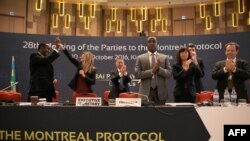The United States’ top environmental regulator this week announced a proposal to intensify an effort to reduce emissions of hydrofluorocarbons (HFCs), a highly potent greenhouse gas, in line with an international agreement the U.S. ratified in September.
The Environmental Protection Agency’s proposal aims at a 40% reduction in the emission of HFCs from historical levels beginning in 2024 by sharply reducing the number of production and consumption allowances that the government issues to businesses that use the chemicals.
HFCs are most widely used in refrigeration and cooling devices, often at an industrial scale. They can also be used in aerosol sprays and in making various kinds of foam.
The U.S. move builds on an existing system of allowances that limits the amount of HFCs in use in the country in a given year. The idea is to reduce the use of the chemicals to bring the U.S. in line with the Kigali Amendment to the Montreal Protocol, an international environmental treaty.
“From day one, President [Joe] Biden promised ambitious action to address the climate crisis and its impacts, which are becoming ever more disruptive and costing billions of dollars every year. Today’s action once again delivers on his promise,” EPA Administrator Michael S. Regan said.
“This proposal also sets the United States on track to meet the goals of the Kigali Amendment, fostering innovation and economic growth in the private sector and reinforcing U.S. leadership in the global fight against climate change,” Regan said.
Environmental groups said they supported the administration’s move, though some wanted additional action.
“The phasedown of HFCs is the type of substantive climate action we hope to see more of from President Biden and his administration,” Charlie Cray, senior research specialist at Greenpeace USA, said in a statement emailed to VOA.
“With safer substitutes readily available there is no need to continue using HFCs, some of which are thousands of times worse for the planet than carbon dioxide,” he said. “This is a positive step if we are going to limit the impacts of the climate crisis.”
Montreal Protocol
The Montreal Protocol is an international agreement that took effect in 1989 and was intended to protect Earth’s ozone layer. It did so by reducing emissions of chemicals that had caused a hole in that layer of the atmosphere to develop over Antarctica, contributing to global warming.
The protocol is largely viewed as a success, because the hole in the ozone layer is on track to be fully repaired between 2050 and 2070.
Ironically, though, the protocol’s original success was due in part to an effort to replace ozone-depleting chlorofluorocarbons (CFCs) with HFCs. Unfortunately, HFCs turned out to be environmentally damaging in a different way.
“They're a very strong greenhouse gas,” Scott Denning, a professor of atmospheric science at Colorado State University, told VOA. “They're actually way more powerful at absorbing outgoing infrared than carbon dioxide is. And so they're causing global warming.”
In fact, HFCs are extraordinarily good at trapping heat in the atmosphere. When scientists measure this, they use a metric known as Global Warming Potential (GWP.) Carbon dioxide, the most common greenhouse gas by volume, has a GWP of 1. Methane, another common greenhouse gas, has a GWP of between 27 and 30, making it far more powerful than carbon dioxide, according to data provided by the EPA.
There are a wide range of HFCs in use around the world, and they do not all have the same GWP. However, according to the EPA, “The GWPs for these gases can be in the thousands or tens of thousands.”
Kigali Amendment
When it became apparent that HFCs were doing their own damage to the environment, the signatories to the Montreal Protocol drafted the Kigali Amendment, which committed nations to phase out their use.
Fortunately, experts are hopeful that the limited number of applications for HFCs around the world will make it less disruptive to reduce and eventually eliminate their use than it would be for a more common greenhouse gas like methane.
“Unlike [carbon dioxide and methane], these HFCs are produced by a much smaller group of producers, and the applications are also much narrower,” Michael Mehling, deputy director of the Center for Energy and Environmental Policy Research at the Massachusetts Institute of Technology, told VOA.
“So it offers the chance to achieve quite a lot on climate change mitigation with just a handful of actors, in a handful of countries, in a relatively short time,” he said.
Big payoff
Because of the high GWP of HFCs, getting them out of production offers enormous environmental benefits relative to the effort involved. The parties to the Montreal Protocol, in adopting the Kigali Amendment, estimated the elimination of HFCs could reduce expected global temperature increases by 0.5 degree Celsius by the end of the century.
While that might not seem like a lot, experts believe it to be extremely meaningful in the worldwide effort to limit global warming to 2 degrees Celsius above the pre-Industrial Revolution average.
“We're really struggling to cut fossil fuel emissions fast enough to hold temperature to 2 degrees above pre-industrial,” said Colorado State’s Denning. “So a half a degree of avoided warming by switching out the fluid in our refrigerators really buys us a lot of time.”
US late to the game
The Kigali Amendment came into force at the beginning of 2019, but during the administration of former President Donald Trump, the U.S. did not move to ratify it. The U.S. didn't ratify the amendment until September of this year.
Nevertheless, the Biden administration had already begun putting in place the system of allowances that the EPA’s proposal draws on to reduce emissions.
Overall, the EPA’s intention is to reduce the amount of HFCs used in the U.S. by 85% by 2036.










